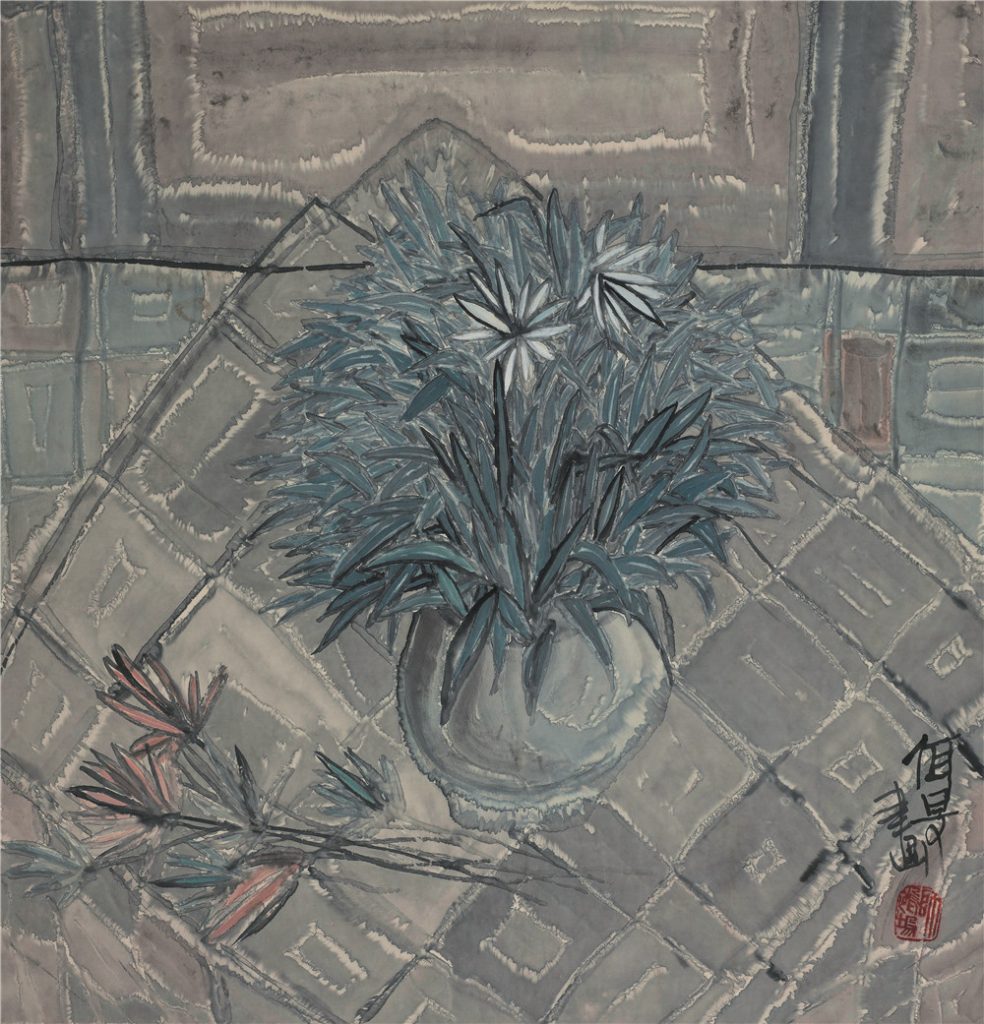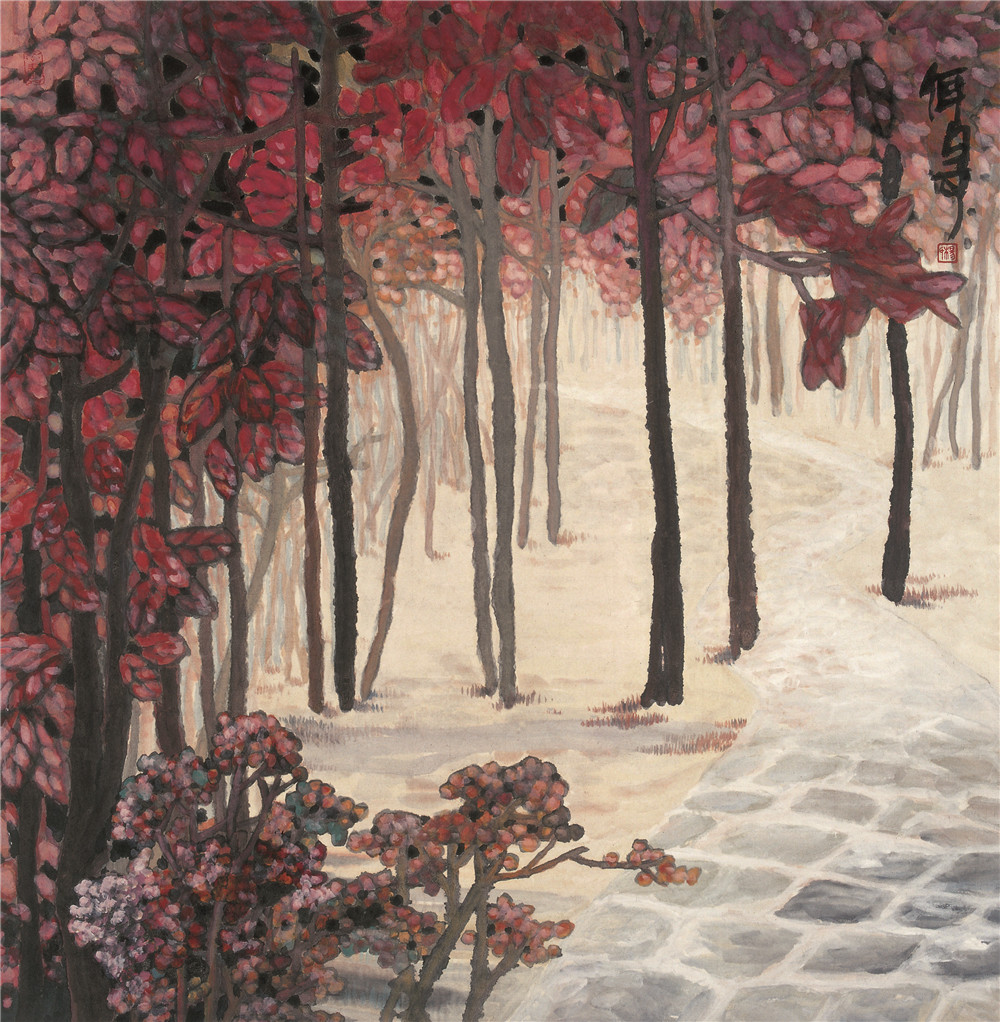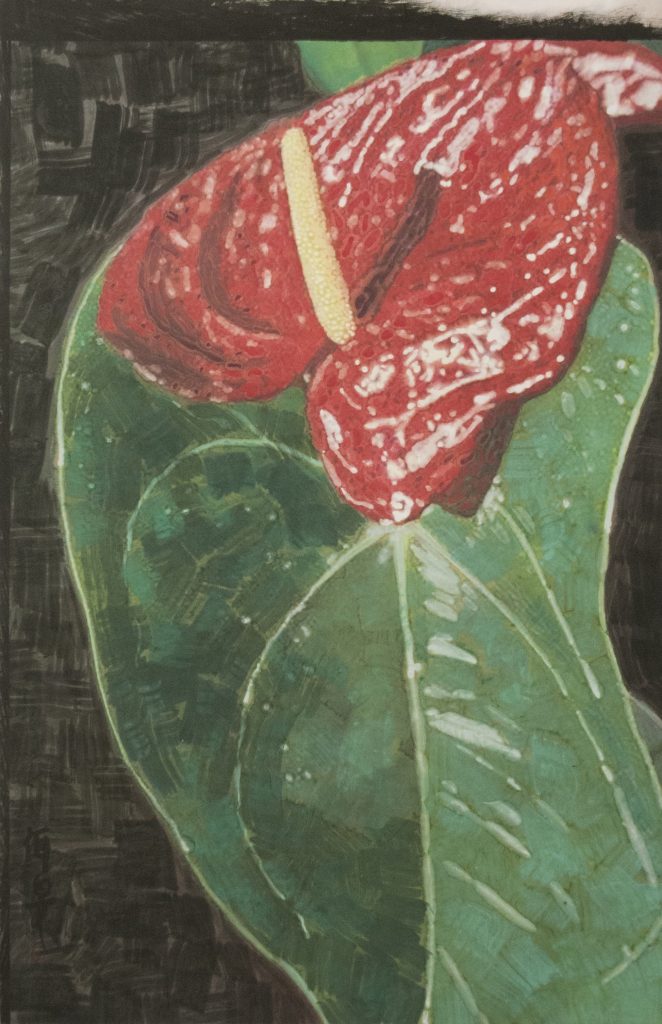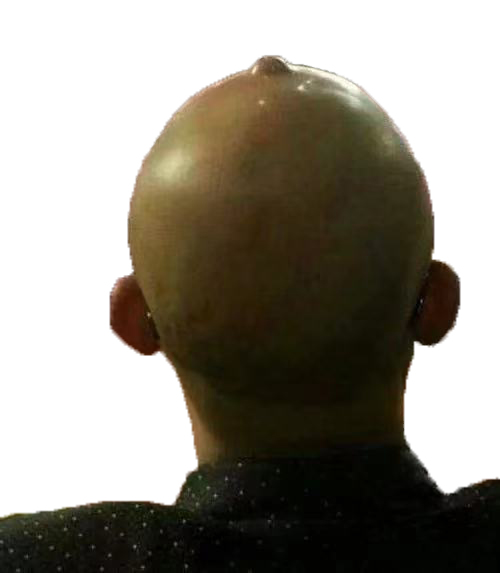Time goes by, since I painted “bái júhuā 白菊花” (White Chrysanthemum Flower”) in 1992, I’ve painted color water ink on xuānzhǐ 宣纸 (Chinese rice paper) for over 20 years. For the past twenty years, there has been few progress in China’s painting field, yet several generations are aging. As an awareness of a middle age man, I think single-color water ink painting has placed some hindrance on painting in nature. In the ancient times painting theories talked about “ink has five colors”, meaning that it looks best when ink color can show heavy and light and from between to give it shades of color. This theory serves to prove that whether in the far ancient times or today people need colors. As to why people didn’t need colors since Song Dynasty, they chose to dilute with water in ink, treated the changes between heavy and light of black as color, this is not a simple issue, I think this had a lot to do with the fundamental qualities of painters at that time and the judgement and direct promotion of scholars and officials at that time.

Chinese paintings, in a narrow sense, refers to interpretive shuǐmòhuà 水墨画(water and ink landscape and painting) with Gōngbǐ zhòngcǎi 工笔重彩(exact delineation and enriched colors). Chinese painting formed the concept since Western painting came to China. Prior to Tang Dynasty Chinese paintings were not single color, yuàn tǐ 院体 (Academy style) painting style in Song Dynasty was mainly colors and lines, additionally, Song Dynasty had another kind of painters who were mostly shìdàfū 士大夫 (scholars) and wénrén 文人(literati). They usually hardly had formal training in painting, and they were very good at writing with brushes, and because they were officials so their interest orientation could impact upper class then expanded, so the drawing under their brushes whether like or unlike painting soon became mainstream. Like or unlike in their hands were something awkward because they didn’t have strict defining skills of objects, they could paint a just about sensation. This type of painting started out as self-entertainment for the officials. The name of “Official’s painting” is close to the calling of “farmer’s painting”, is called based on the status of painters. This also differs from formal yuàn tǐ 院体 (Academy style). In a country of Guan Ben Wei (over values Officials) like China, officials taste and Official’s paintings got hugely advanced with their promoting effort. At this point the history of Chinese art has thus taken a turn, self-entertaining has basically become the tradition for
Chinese painting. The yuàn tǐ 院体 which was the original tradition has become the substitute name of poor taste or rigid craftsmanship, which has been taken backwards for a good few hundred years.
I began to explore Chinese painting with colors, now to reflect that, it was quite accidental. Because for someone who painted with single color since young age, he probably grew accustomed to forgetful about real colors, and may even turn a blind eye to colors. I remembered when I was at college, I was painting landscapes in classroom, I was adding colors on the mountain range with ochre and cyanine over the black ink creases, as I was painting the fellow who was watching asked me: “There are so many colors how come you only use those two (color) tubes and leaving alone the rest?” At that I froze, then automatically went to count the color tubes in that box, there are 12 of them. Well yes, there’re so many colors why not use them! Painters usually won’t notice things like this, because they were trained a habit, since young age, to only see ink color in their eyes, and have lost sight of real colors already. I wasn’t sure if he was sent by God, I only knew what he said is very important to me, it was then when I began to explore colors on xuānzhǐ 宣纸 (Chinese rice paper), intentionally or not. I was asked about the differences between qīnglǜ shānshuǐ 青绿山水(traditional landscape painting characterized by the prominence of blue and green colors) and my ink water painting, qīnglǜ shānshuǐ 青绿山水 is to illustrate with two single colors of blue and green, it’s similar to painting with single color of ink, which is the same concept. The ancient painting theory of “suí lèi fù cǎi”随类赋彩 (coloring adhere to the type) speaks keeping to the original colors, meaning what color is the mountain stones trees and wood, then painters should color them in those colors. In the wénrénhuà 文人画(literati paintings), since the tone of the painting is single-colored, and ink mixed with water to show darker or lighter shades which was considered color, and in these cases “suí lèi fù cǎi”随类赋彩 (coloring adhere to the type) becomes to coat a similar light color over the ink base painting. In traditional Chinese painting, colors are supplement, which is to replenish to the shortage of color. This reminds me of coloring on black and white photos several decades ago.

There’re so many colors for Chinese painting, how come chose to dilute black ink, to show darkness from lightness to be called colors? Other than what was illustrated earlier, there were many factors including cultural and emotional factors, it was quite complicated. This case has been there in the history of Chinese art for a very long time. Chinese painters have explored painting in ink and in single color, there’ve been quite many painters and they’ve done it for a long time and have gained lots of experience and have accomplished a lot. However, in my opinion, down the road of Chinese painting, there ought to be more than one way, there must be a colorful path, otherwise it must be quite piteous. I have explored on the path of shuǐmòhuà 水墨画 for over several decades, my technique of freehand illustrating with colors has reached maturity over the time.
Now here comes the need to talk about change of the concept, change a different perception. Above everything else, my new shuǐmòhuà 水墨画 is a change of perception, in the past people were only painting with single color, I think it’s the result of no painters have attempted painting with color experiment on material. It’s not that Chinese painters were incompetent with colors but that of the perception. If there ever was a fear of putting colors on xuānzhǐ 宣纸, it should be relieved now.
Additionally there existed a mode of thought, when seeing colors people will think that’s Western painting, when in fact that’s a big mistake. Colors is not the solely for Western painting, colors of course belong to the Orient, colors are the fundamental component for any kind of painting. Certainly, do not take it for granted that the shiny colors on xuānzhǐ 宣纸 is an easy thing to make. Mr. Xú Bēihóng 徐悲鸿先生 has said that xuānzhǐ 宣纸 does go near colors, meaning that xuānzhǐ 宣纸 doesn’t show colors well. Color has been one of the big problem for the advance of Chinese painting for hundreds of years!
-纸本设色-171.5cmx95.4cm-2019年-568x1024.jpg)
In the era of great transformation, the society of China is going through the biggest reformation in human history. Stepping outbound, almost everyone is walking outbound, some have landed in cities, some have reached abroad. Shuǐmòhuà 水墨画 is walking from tradition to modern, and has landed on the world stage from being self-entertaining and self-appreciation. The society is under transformation, traditional wénrén 文人 and shìdàfū 士大夫 are no longer here, instead they’re replaced by creative groups housed mainly in musuem of culture, XX art academy, universities, and professional artists. The thousand years old tradition that XX took the place of painters should be ended.
With this large size of land and population, China, should contribute greatly to the world. Since the modern time, we have taken many inventions by others: science, medical, arts, etc. All these indeed have enriched our lives and made us healthier. Yet with what should we present to the world? Myself being a painter, with my unremitting pledged endeavor, I hope we could convert the local dialect of ancient Chinese painting to a world language. To give a speech in Chinese in the street of Paris which significance may be minor, yet the transformed Chinese painting is something that we contribute origionally.
The maturing of a new technique means the establishment of a new form, which fills the language vacuum in the splitting progress between modern shuǐmò 水墨 (water ink painting) and classic shuǐmò 水墨. This is truly significant!


